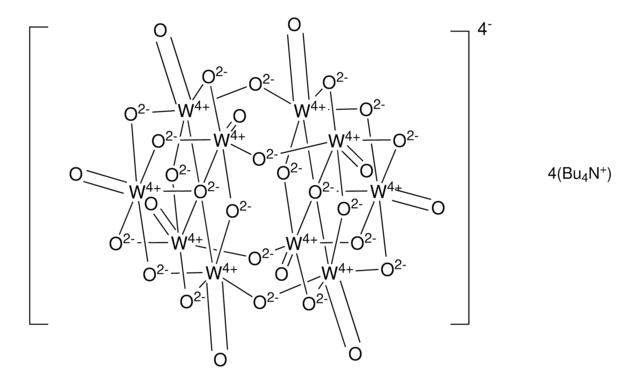224758
Tris(2,2′-bipyridyl)dichlororuthenium(II) hexahydrate
powder
Synonym(s):
Ru(BPY)3, Ruthenium-tris(2,2′-bipyridyl) dichloride, Tris(2,2′-bipyridyl)ruthenium(II) chloride hexahydrate
About This Item
Recommended Products
form
powder
reaction suitability
core: ruthenium
reaction type: Photocatalysis
reagent type: catalyst
mp
>300 °C (lit.)
photocatalyst activation
450 nm
SMILES string
[H]O[H].[H]O[H].[H]O[H].[H]O[H].[H]O[H].[H]O[H].Cl[Ru]Cl.c1ccc(nc1)-c2ccccn2.c3ccc(nc3)-c4ccccn4.c5ccc(nc5)-c6ccccn6
InChI
1S/3C10H8N2.2ClH.6H2O.Ru/c3*1-3-7-11-9(5-1)10-6-2-4-8-12-10;;;;;;;;;/h3*1-8H;2*1H;6*1H2;/q;;;;;;;;;;;+2/p-2
InChI key
WHELTKFSBJNBMQ-UHFFFAOYSA-L
Looking for similar products? Visit Product Comparison Guide
General description
Application
- Used in the synthesis of hybrid catalysts which are used in oxidase based biosensors.
- Used as a luminophore for multiplexed signalling in bio analysis.
- Used in oxygen assesment in living cells.
Product can be used with our line of photoreactors: Including Penn PhD (Z744035) & SynLED 2.0 (Z744080)
related product
Storage Class Code
11 - Combustible Solids
WGK
WGK 3
Flash Point(F)
Not applicable
Flash Point(C)
Not applicable
Personal Protective Equipment
Certificates of Analysis (COA)
Search for Certificates of Analysis (COA) by entering the products Lot/Batch Number. Lot and Batch Numbers can be found on a product’s label following the words ‘Lot’ or ‘Batch’.
Already Own This Product?
Find documentation for the products that you have recently purchased in the Document Library.
Customers Also Viewed
Electrogenerated Chemiluminescence Sensing
Related Content
Research in the Stephenson lab focuses upon the development of new chemical methods which enable the activation of chemical bonds under mild reaction conditions.
One major theme of research in the Yoon lab is the development of unique chemical transformations enabled by visible light photochemistry. A variety of transition metal photocatalysts responsive to visible light are known, and the Yoon lab has shown that their well understood photochemistry can be coupled to cycloadditions, arene oxidations, amine functionalizations, and thiol-ene reactions, among others.
Our team of scientists has experience in all areas of research including Life Science, Material Science, Chemical Synthesis, Chromatography, Analytical and many others.
Contact Technical Service




![[Ru(phen)3]Cl2 ≥95%](/deepweb/assets/sigmaaldrich/product/structures/955/596/46f63eaa-39f8-4058-847d-cef0862ada92/640/46f63eaa-39f8-4058-847d-cef0862ada92.png)
2 ≥95%](/deepweb/assets/sigmaaldrich/product/structures/190/371/c5efe61d-383f-4364-90c6-1912d88674f3/640/c5efe61d-383f-4364-90c6-1912d88674f3.png)

![[Ru(bpz)3][PF6]2 95%](/deepweb/assets/sigmaaldrich/product/structures/317/925/f0ef928e-bbea-4535-abe6-dda0bc28d32a/640/f0ef928e-bbea-4535-abe6-dda0bc28d32a.png)


![[Ir(dtbbpy)(ppy)2]PF6](/deepweb/assets/sigmaaldrich/product/structures/158/329/2544d673-d267-4aa1-8f46-2652aad4bfa0/640/2544d673-d267-4aa1-8f46-2652aad4bfa0.png)
2 ≥95%](/deepweb/assets/sigmaaldrich/product/structures/238/198/d2398f4d-117e-4482-8d8b-80ae657f6ea1/640/d2398f4d-117e-4482-8d8b-80ae657f6ea1.png)